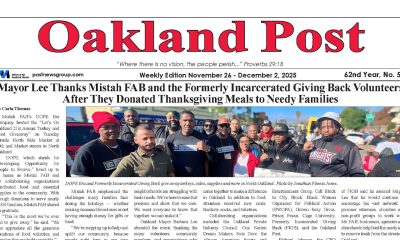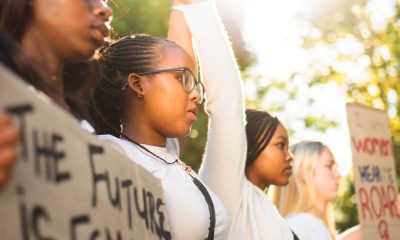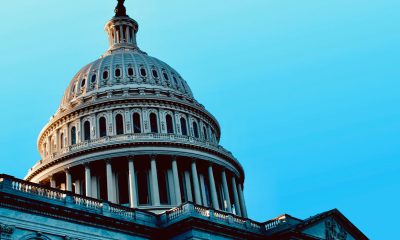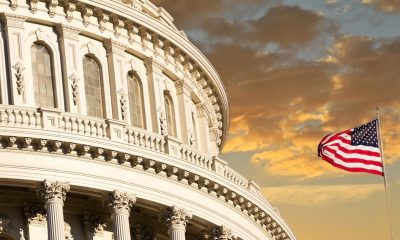National
Legacy of ‘First Lady of the Black Press’ Still Relevant Today
By Jazelle Hunt
NNPA Washington Correspondent
WASHINGTON (NNPA) – When James McGrath Morris set out to write his latest book, he didn’t know how timely it would be. When Eye on the Struggle: Ethel Payne, The First Lady of the Black Press hit shelves, Essence magazine had just released its Black Lives Matter issue. The Justice Department had closed its investigation into Trayvon Martin’s murder, with no charges. Mainstream media was scrambling to report on police violence and systemic racial ills, and Black Americans took much of this coverage to task for its racist, shallow, or negligent portrayals.
“We get these events filtered through the mainstream media. The mainstream media is still very White. I don’t mean they don’t hire people of color…it’s a perspective issue. The fact the media had a debate over the use of the word ‘terrorist’ [for Dylann Roof] in South Carolina is an indication,” said Morris.
“So what I found is that Ethel Payne’s story, her perspective, her form of journalism 50 years ago, still has relevance today. Because while we may have made leaps in terms of segregation…the dominant filter today remains a White-controlled media.”
Ethel Payne was poking holes in that filter at a time when the White majority fought against the tide of sustained agitation to secure civil and human rights for all. At the Chicago Defender, Payne was the eyes and ears of the Civil Rights Movement, reporting from its front lines in the Deep South, press conferences at the White House, and iconic rulings at the Supreme Court. In 1953, she became the third Black person to join the White House Press Corps, and was known for persistently prodding President Dwight D. Eisenhower on Jim Crow laws and desegregation efforts.
In the ’50s and ’60s, she jetted around the globe for international stories such as Black soldiers in Vietnam and the Nigerian Civil War, becoming the first Black woman to be a fulltime foreign correspondent. Yet, she always returned for on-the-ground coverage of moments that would become history, like the start of the Montgomery bus boycott and the desegregation of Little Rock, Ark.’s Central High School.
In 1972, Payne joined CBS and became the first Black woman commentator at a major network. In 2002, she was memorialized on a postage stamp.
With 40 years of tireless journalism and a legacy honed at a Black-owned newspaper, Payne earned her reputation as the “First Lady of the Black Press.”
“When The New York Times or The Washington Post would report on the passage of the Civil Rights Act of ‘64 or the Voting Rights Act of ‘65, the tone of the articles was that these were munificent gifts being given to a disenfranchised people,” Morris said.
“Whereas, if you opened up the Afro American or the Pittsburgh Courier or Chicago Defender, what you were seeing was coverage of the fact that these were victories, hard-won victories by people who laid their lives on the line. Nothing was being given. In fact, [Payne’s] coverage often highlighted the inadequacies of these pieces of legislation.”
In the early ‘70s, Ernest Green, a member of the Little Rock Nine, made a quip to Payne about what desegregation would do to such coverage.
“He said to her that the successes she and others made with the Civil Rights Movement were going to put the Black Press out of business. Obviously, that was too strong of a determination, because there’s still a viable Black press, but his bigger point was right in that the White media was going to raid the Black press for the best reporters, offer them jobs at much higher pay. And if you’re raising a family, what are you going to do?” Morris recounted.
“Many of the best reporters were lured away. But also, importantly, the economic basis of the Black press was undercut. Because when the White press refused to cover Black communities – high school tournaments, weddings, graduations, obituaries – there was an economic reason for [Black papers].”
Further, another side effect of integration and the Civil Rights Movement is that subsequent generations do not get a thorough and true education on Black history, or how the Movement happened. Payne said as much at a speaking engagement at her childhood church, [Greater] St. John A.ME. Church.
“She told her audience that, ours was a generation who laid their lives on the line to send our kids to college, but in doing so forgot to tell them our story. I like to expand that…we tend to teach the Civil Rights Movement focused on its leadership,” he said.
“Ethel Payne was part of the lesser-known group, she’s in the second, third tier of the Civil Rights Movement. I see younger people…waiting for somebody else to come and lead them. But these movements come from everyday people.”
Morris, a former journalist who also taught high school history for a decade, has been writing biographies and narrative nonfiction for many years. In searching for a new subject, he stumbled upon Payne’s name, which was unknown to him at the time. With a little more research, he was startled to find that few historians had taken a deep look at her contributions to journalism and the Civil Rights Movement.
“For me, [this book] has been the greatest experience of my life. It’s been really an honor, for me as an author, to do a book that matters,” Morris said. “I’ve had the privilege of learning that race really matters, but I didn’t know it because I was able to stay removed from it. That, to my mind, is Ethel Payne’s gift to me.”
Payne’s personal papers and journals are housed in Washington, D.C. with the Library of Congress’ Manuscript Division and the Moorland-Spingarn Research Center at Howard University, and in New York at the Schomburg Center for Research in Black Culture.
Eye on the Struggle: Ethel Payne, The First Lady of the Black Press is available at major book retailers. Signed copies can be purchased via www.jamesmcgrathmorris.com/eyeonstruggle.html.
“She went as a reporter to the front lines of the Civil Rights Movement…to report back to African Americans…to activate them,” Morris said. “The more people learn about Ethel Payne, I think they too will feel a sense of power.”
Activism
Oakland Post: Week of December 24 – 30, 2025
The printed Weekly Edition of the Oakland Post: Week of – December 24 – 30, 2025

To enlarge your view of this issue, use the slider, magnifying glass icon or full page icon in the lower right corner of the browser window.
Activism
Desmond Gumbs — Visionary Founder, Mentor, and Builder of Opportunity
Gumbs’ coaching and leadership journey spans from Bishop O’Dowd High School, Oakland High School, Stellar Prep High School. Over the decades, hundreds of his students have gone on to college, earning academic and athletic scholarships and developing life skills that extend well beyond sports.

Special to the Post
For more than 25 years, Desmond Gumbs has been a cornerstone of Bay Area education and athletics — not simply as a coach, but as a mentor, founder, and architect of opportunity. While recent media narratives have focused narrowly on challenges, they fail to capture the far more important truth: Gumbs’ life’s work has been dedicated to building pathways to college, character, and long-term success for hundreds of young people.
A Career Defined by Impact
Gumbs’ coaching and leadership journey spans from Bishop O’Dowd High School, Oakland High School, Stellar Prep High School. Over the decades, hundreds of his students have gone on to college, earning academic and athletic scholarships and developing life skills that extend well beyond sports.
One of his most enduring contributions is his role as founder of Stellar Prep High School, a non-traditional, mission-driven institution created to serve students who needed additional structure, belief, and opportunity. Through Stellar Prep numerous students have advanced to college — many with scholarships — demonstrating Gumbs’ deep commitment to education as the foundation for athletic and personal success.

NCAA football history was made this year when Head Coach from
Mississippi Valley State, Terrell Buckley and Head Coach Desmond
Gumbs both had starting kickers that were women. This picture was
taken after the game.
A Personal Testament to the Mission: Addison Gumbs
Perhaps no example better reflects Desmond Gumbs’ philosophy than the journey of his son, Addison Gumbs. Addison became an Army All-American, one of the highest honors in high school football — and notably, the last Army All-Americans produced by the Bay Area, alongside Najee Harris.
Both young men went on to compete at the highest levels of college football — Addison Gumbs at the University of Oklahoma, and Najee Harris at the University of Alabama — representing the Bay Area on a national level.
Building Lincoln University Athletics From the Ground Up
In 2021, Gumbs accepted one of the most difficult challenges in college athletics: launching an entire athletics department at Lincoln University in Oakland from scratch. With no established infrastructure, limited facilities, and eventually the loss of key financial aid resources, he nonetheless built opportunities where none existed.
Under his leadership, Lincoln University introduced:
- Football
- Men’s and Women’s Basketball
- Men’s and Women’s Soccer
Operating as an independent program with no capital and no conference safety net, Gumbs was forced to innovate — finding ways to sustain teams, schedule competition, and keep student-athletes enrolled and progressing toward degrees. The work was never about comfort; it was about access.
Voices That Reflect His Impact
Desmond Gumbs’ philosophy has been consistently reflected in his own published words:
- “if you have an idea, you’re 75% there the remaining 25% is actually doing it.”
- “This generation doesn’t respect the title — they respect the person.”
- “Greatness is a habit, not a moment.”
Former players and community members have echoed similar sentiments in public commentary, crediting Gumbs with teaching them leadership, accountability, confidence, and belief in themselves — lessons that outlast any single season.
Context Matters More Than Headlines
Recent articles critical of Lincoln University athletics focus on logistical and financial hardships while ignoring the reality of building a new program with limited resources in one of the most expensive regions in the country. Such narratives are ultimately harmful and incomplete, failing to recognize the courage it takes to create opportunity instead of walking away when conditions are difficult.
The real story is not about early struggles — it is about vision, resilience, and service.
A Legacy That Endures
From founding Stellar PREP High School, to sending hundreds of students to college, to producing elite athletes like Addison Gumbs, to launching Lincoln University athletics, Desmond Gumbs’ legacy is one of belief in young people and relentless commitment to opportunity.
His work cannot be reduced to headlines or records. It lives on in degrees earned, scholarships secured, leaders developed, and futures changed — across the Bay Area and beyond.
Activism
Families Across the U.S. Are Facing an ‘Affordability Crisis,’ Says United Way Bay Area
United Way’s Real Cost Measure data reveals that 27% of Bay Area households – more than 1 in 4 families – cannot afford essentials such as food, housing, childcare, transportation, and healthcare. A family of four needs $136,872 annually to cover these basic necessities, while two adults working full time at minimum wage earn only $69,326.

By Post Staff
A national poll released this week by Marist shows that 61% of Americans say the economy is not working well for them, while 70% report that their local area is not affordable. This marks the highest share of respondents expressing concern since the question was first asked in 2011.
According to United Way Bay Area (UWBA), the data underscores a growing reality in the region: more than 600,000 Bay Area households are working hard yet still cannot afford their basic needs.
Nationally, the Marist Poll found that rising prices are the top economic concern for 45% of Americans, followed by housing costs at 18%. In the Bay Area, however, that equation is reversed. Housing costs are the dominant driver of the affordability crisis.
United Way’s Real Cost Measure data reveals that 27% of Bay Area households – more than 1 in 4 families – cannot afford essentials such as food, housing, childcare, transportation, and healthcare. A family of four needs $136,872 annually to cover these basic necessities, while two adults working full time at minimum wage earn only $69,326.
“The national numbers confirm what we’re seeing every day through our 211 helpline and in communities across the region,” said Keisha Browder, CEO of United Way Bay Area. “People are working hard, but their paychecks simply aren’t keeping pace with the cost of living. This isn’t about individual failure; it’s about policy choices that leave too many of our neighbors one missed paycheck away from crisis.”
The Bay Area’s affordability crisis is particularly defined by extreme housing costs:
- Housing remains the No. 1 reason residents call UWBA’s 211 helpline, accounting for 49% of calls this year.
- Nearly 4 in 10 Bay Area households (35%) spend at least 30% of their income on housing, a level widely considered financially dangerous.
- Forty percent of households with children under age 6 fall below the Real Cost Measure.
- The impact is disproportionate: 49% of Latino households and 41% of Black households struggle to meet basic needs, compared to 15% of white households.
At the national level, the issue of affordability has also become a political flashpoint. In late 2025, President Donald Trump has increasingly referred to “affordability” as a “Democrat hoax” or “con job.” While he previously described himself as the “affordability president,” his recent messaging frames the term as a political tactic used by Democrats to assign blame for high prices.
The president has defended his administration by pointing to predecessors and asserting that prices are declining. However, many Americans remain unconvinced. The Marist Poll shows that 57% of respondents disapprove of Trump’s handling of the economy, while just 36% approve – his lowest approval rating on the issue across both terms in office.
-

 #NNPA BlackPress4 weeks ago
#NNPA BlackPress4 weeks agoLIHEAP Funds Released After Weeks of Delay as States and the District Rush to Protect Households from the Cold
-

 Activism4 weeks ago
Activism4 weeks agoOakland Post: Week of November 26 – December 2, 2025
-

 Alameda County3 weeks ago
Alameda County3 weeks agoSeth Curry Makes Impressive Debut with the Golden State Warriors
-

 #NNPA BlackPress4 weeks ago
#NNPA BlackPress4 weeks agoSeven Steps to Help Your Child Build Meaningful Connections
-

 #NNPA BlackPress4 weeks ago
#NNPA BlackPress4 weeks agoSeven Steps to Help Your Child Build Meaningful Connections
-

 #NNPA BlackPress4 weeks ago
#NNPA BlackPress4 weeks agoTrinidad and Tobago – Prime Minister Confirms U.S. Marines Working on Tobago Radar System
-

 #NNPA BlackPress4 weeks ago
#NNPA BlackPress4 weeks agoThanksgiving Celebrated Across the Tri-State
-

 #NNPA BlackPress4 weeks ago
#NNPA BlackPress4 weeks agoTeens Reject Today’s News as Trump Intensifies His Assault on the Press






















































